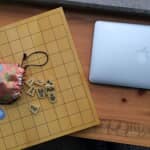8 January 2019
No Worry! Even Preschool Children Will Come to Like Shogi with These 5 Practices
Preschool children, who are around 5 years old, are likely to squirm in a seat. Adding to the problem, not a few Shogi teachers and parents might have a difficulty to find appropriate learning materials.
Providing tips to these problems, I will introduce what I am doing in i-tsu-tsu Shogi classes, using of our textbook, Shogi Lesson Book for Beginners Vol. 1.
1. For Boys, Adapting Game Elements to Keep Their Interest
According to my teaching experiences, girls tend to adjust themselves easier than boys to what they are supposed to do in a class. Boys often lose interest and get distracted easily when they have to follow the ordinal lesson curriculum. To solve the matter, I incorporate game elements into Shogi lessons. Because boys tend to show a preference for fighting or competing, I take advantage of their preferences in my lessons.
2. Stamps Make Practices More Fun and Easier
In our Shogi textbook, Shogi Lesson Book for Beginners Vol. 1, as the first lesson, you will learn the kinds of Shogi pieces and how to move them. The textbook has a question to ask you to write down circles on squares to which a piece can move. Preschool children sometimes find it difficult to describe a circle with a pen. Even so, they try to write a circle as much as they can, but gradually they get tired of this task.
In such case, stamps may help them. Stamps make the task to describe a circle much easier and fun, especially when you use a stamp with a cute illustration. I remember when I advised a student to use a illustrated stamp, the student seemed to be very happy and enjoy it.

3. Stickers Will Give Children A Feeling of Accomplishment
Our Shogi textbook, Shogi Lesson Book for Beginners Vol. 1, has a page with a chart that you can put stickers. After finishing a lesson, you can put a sticker on the space corresponding to the lesson day. Collecting stickers on the page, children know progress easily.
As you know, children love stickers. “Today, we done four lessons and I can put four stickers!”, they said happily.
Looking at their happy faces, I realize the importance of having a feeling of accomplishment. Before starting a lesson, let’s give them a goal to be completed in the lesson, saying “We are going to put four stickers after the lesson!” Children must get motivated and enjoy completing not only one day’s lesson, but also three extra days’ lessons.
By the way, giving a cute nickname to stickers is also a good idea to motivate children, I think.

4. Small Shogi Board Saves Time for Children
To finish a Shogi game, you must capture your opponent’s Gyoku (King). You need to have enough experiences in real games to understand how to capture Gyoku (King) and having enough such experiences require you to take a certain amount of time. Preschool children, who are Shogi beginners, usually don’t have enough experiences and often fail to capture Gyoku (King).
We provide practices in our Shogi textbook, Shogi Lesson Book for Beginners Vol. 1, to capture Gyoku (King), using a small Shogi board with 5 x 5 squares. We use a small board for practices to give Check or to capture Gyoku (King), because they shorten total amount of time for one game and allow us to save time. When children practice to capture Gyoku (King) with a teacher, I also recommend that you set a rule under which a teacher won’t capture Gyoku (King).
There is one thing you need to note. Using small Shogi boards changes the rule of pieces promotions. For your information, this is applied to Shogi, but to Igo.
When you use the general size of Shogi board, your piece will get promoted on reaching the third rank. But with a small board, promotions are taken place on the first rank. Therefore, you need to be careful not to make children confused and to determine if children’s abilities are good enough to use a small board.

5. Good Analogies Help Children to Learn Shogi
In one of my classes, there is a boy who likes fishes very much. I often notice that he contains fish names into his daily conversation. I wanted him to take a liking to Shogi as well, and decided to use analogy of fishes to explain Shogi piece-moves. Such as, “Hisha (Rook) moves a lot like a marlin.” or “Kin (Gold) moves like a ray.” I don’t care too much about which fish goes with which piece. Instead, I just make analogies using children’s favorites.
You compare piece-moves to children’s favorites and may have good conversations with them. Preparing some analogies beforehand is okay, but if you teach small number of students in a class, I would recommend asking children’s favorite things and using them to make connections with Shogi.
Special Episode
I would like to introduce something more. It’s not related to teaching Shogi, but worked very well to get preschool children’s interest.
Special Tickets
It’s a bit difficult for preschool children to keep the focus on Shogi for one hour. In a Shogi class that I am teaching in Fucyu, Tokyo, we sit on the floor, placing Japanese cushion under the legs. This style tempts children into lie down on the floor.
Lying down during a lesson is not good manner, of course. But just warning them not to do won’t work, or even worse. I give them special tickets to allow them to do that. “You have only two tickets to lie down!”, I told them. They said, “Really? Should I use one now, or later…?” They tried to manage to use the tickets. Now, children’s trend is to keep tickets until the end of a class.
I am, incidentally, thinking to reduce the number of tickets from two to one, after the class gets older.
If you provide a reasonable rule, even preschool children can follow it. I believe it will work more effectively for small children to present what they are supposed to do, instead of just saying “No”.
So far, I wrote my ideas to make lessons more fun. What do you think about them? It’s more challenging to teach Shogi to preschool children than to primary school children. Even if it is the case, as long as preschool children are interested in Shogi, teaching them Shogi is rewarding. Preschool children’s possibilities can be developed unlimitedly. They willingly soak up skills and information from a teacher, when they are provided with enjoyable game elements or conversations in a lesson. Once they learn the joy of Shogi, I believe they will keep enjoying Shogi.
We are offering a variety of products which are suitable for preschool children. For more details, please check out website.


